Share triggers are what make the difference between blog posts that fizzle out quickly and blog posts that travel the web for months on end, generating social interaction, traffic, and backlinks.
In this article, I’ll show you the 11 share triggers that make blog posts go viral.
The 11 Share Triggers That Make Blog Posts Go Viral
Share triggers are the secret ingredients that trigger a powerful emotional response in readers, compelling them to hit that “share” button without a second thought.
Understanding and harnessing these triggers can be the key to crafting blog posts that resonate deeply with your target audience, fostering engagement, and skyrocketing your online reach.
Here are eleven share triggers to consider using in your next blog post.
#1. Write Listicles
Listicles are one of the most powerful share triggers in the blogosphere.
The word listicle is a combination of ‘list’ and ‘article’ – a listicle is simply an article written as a list.
Critics don’t like listicles – they regard them as a new phenomenon that’s dumbing down the way we read and write.
But the listicle has a long and venerable tradition – remember the 10 Commandments?
And in any case, listicles are hugely popular. BuzzFeed built its business almost entirely on listicles and was getting about 70 million US readers a month in 2017.
Noah Kagan analyzed 100 million articles and found that list posts came only second to Infographics as the most shared content on the web:
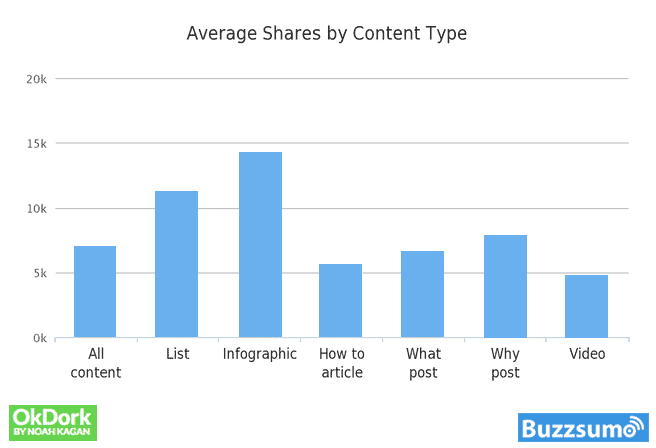
Why so popular?
Listicles appeal to the way the brain processes and organizes information.
We have a natural human tendency to divide the world up into categories. And that’s exactly what listicles do.
They place small bites of information into a structure that can be easily digested.
With the explosive growth of the Internet we’re now flooded with information like never before. Most people simply feel overwhelmed.
One way we deal with this overload is through inspectional reading. That’s where you scan an article before making a commitment to read it.
Listicles are ideal for inspectional readers – you can quickly see exactly what you’re going to get. And that allows you to make a quick decision whether to commit to reading the whole thing.
How to write listicles
Listicles are not only easy to read, they’re also incredibly easy to write.
Remember all those elegant transitions that allow the writer to segue from one topic to the next?
Well, in a listicle you don’t need them and the reader doesn’t expect them.
Here are some key tips for writing listicles:
- Define your overall topic
- Number each listicle item
- Make each item in your list a separate point
- Start with more material and then prune back
- Consider grouping your points by sub-topic if you have more than 30 points
- Put lists within your list (as I’m doing now)
- Indicate in the title the number of points in your listicle
- Use an odd number in the listicle title (though some people swear by the number 10)
- Use superlatives in your title
- Close your listicle with a concise summary
- The longer and more detailed your listicle, the better.
Combine listicles with long form content
If you want to get some serious shares, try combining listicles with long form content.
This is what Brian Dean calls the ‘Expanded List Post’ (ELP). And he’s had great success with them!
Here’s an example of one his ELPs: 17 Untapped Backlink Sources (2,400 words in length).
#2. Create Roundup Posts
Of all the share triggers I’ve used, roundup posts are the king. They have built-in shareability and they can result in insane numbers of shares.
One of my roundup posts, The Top 50 Marketing Experts on Twitter, has 860 shares.
And I didn’t promote it at all. The people mentioned in the article did all the promoting. That’s what I mean by built-in shareability.
Here are some of my other roundups, with shares in brackets:
- 19 Experts Reveal Their Top Tips For First Year Bloggers (629 shares)
- 71 Online Entrepreneurs Reveal Their Email Preferences (434 shares)
- The Top 30 Marketers on Pinterest (427 shares)

How to write roundup posts
So, how do you write a roundup post?
Simple. Just choose a question that you think your readers would like answers to.
Then approach 20 to 50 experts and ask them if they could give a 50- to 100-word response.
Tips for writing roundup posts
Here are some tips for compiling roundup posts:
- Ask a question your experts can answer in about 5 to 10 minutes – any longer and they won’t bother to reply (they’re busy people, like all of us)
- Try to avoid asking questions they’ve already answered in previous roundups – they’re more likely to respond if you come up with something new
- Use your own learning process to come up with the question – the challenges you encounter along the way are likely to be those of your audience as well
- Use BuzzSumo to find trending topics
- Be very specific. The more specific your question, the more likely it is you’ll get a response. Instead of asking “How important is search traffic in your online business?” ask “What’s the single most valuable SEO tip you would give to a novice blogger?”
- Some questions will produce similar responses. If you ask: “What’s the fastest way of building an email list?” at least half your experts will likely respond: “use a Lead Magnet”. That’s not going to make a very interesting roundup post. Instead, ask personal questions, such as: “What was the biggest mistake you made in your first year of blogging” or “How did you make your first $1K dollars online?”
- Turn your roundup into a survey of what tools the experts use. That’s very useful information as it helps your readers decide what tools to choose. Also, the response can be as little as 3 words (the shorter the response required, the more likely you’ll get a reply)
#3. Ask For Shares
You may think it’s cheeky or even rude to ask for shares.
But as the old saying goes, “If you don’t ask, you don’t get”.
Or, as the apostle James said: “Ye have not because ye ask not” (James 4:2).
It’s fine to ask for shares if you think you’ve written a great article.
When I send my latest blog post out to my email list, I always ask my readers to share it if they found it useful.
You can also ask people to share at the end of your article.
#4. Make It Easy To Share
This is the most obvious of all share triggers – make it easy to share.
Here are three things you can do to make your blog posts easier to share:
Add floating share buttons to your blog posts
There are share buttons and there are *floating* share buttons. It’s really important you use the latter, if you want to get more social shares.
I use the Social Warfare WordPress plugin.
Other plugins that offer floating share buttons are:
Embed ready made tweets
Embed ‘Tweetables’ or ‘Click To Tweet’ quotes several times throughout your article.
I use the ‘Click to Tweet’ function that comes with the Social Warfare plugin:
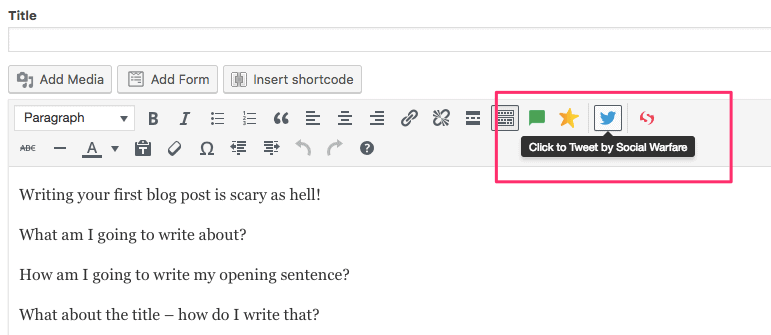
Just click on the Twitter icon while editing your post, type in the text you want to appear, and you’ll get a Shortcode that you drop straight into the text of your article:
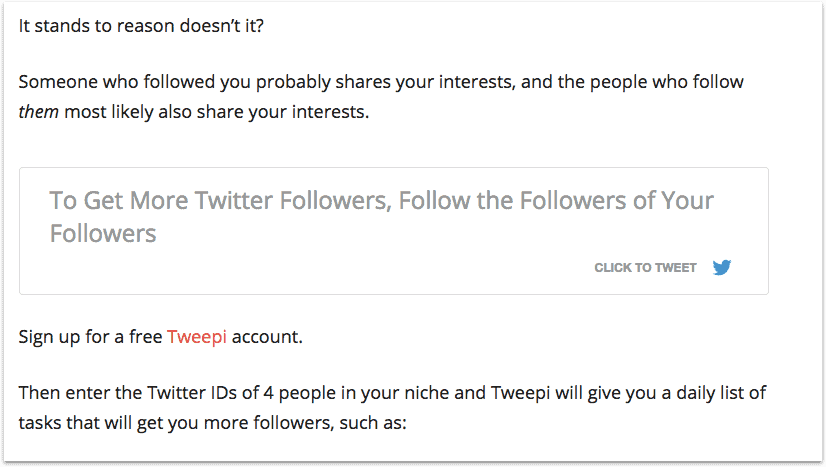
Other services that do the same thing:
- Click To Tweet (online service, not a plugin)
- Click To Tweet (WordPress plugin)
- TweetDis (WordPress plugin)
Optimize Open Graph Tags
Optimize the Open Graph Tags for the different social medial platforms.
Open graph tags allow you to control the way your posts appear on the various social media platforms.
Install Yoast’s free SEO plugin and then go to the bottom of the blog post edit page and click on the Share button:
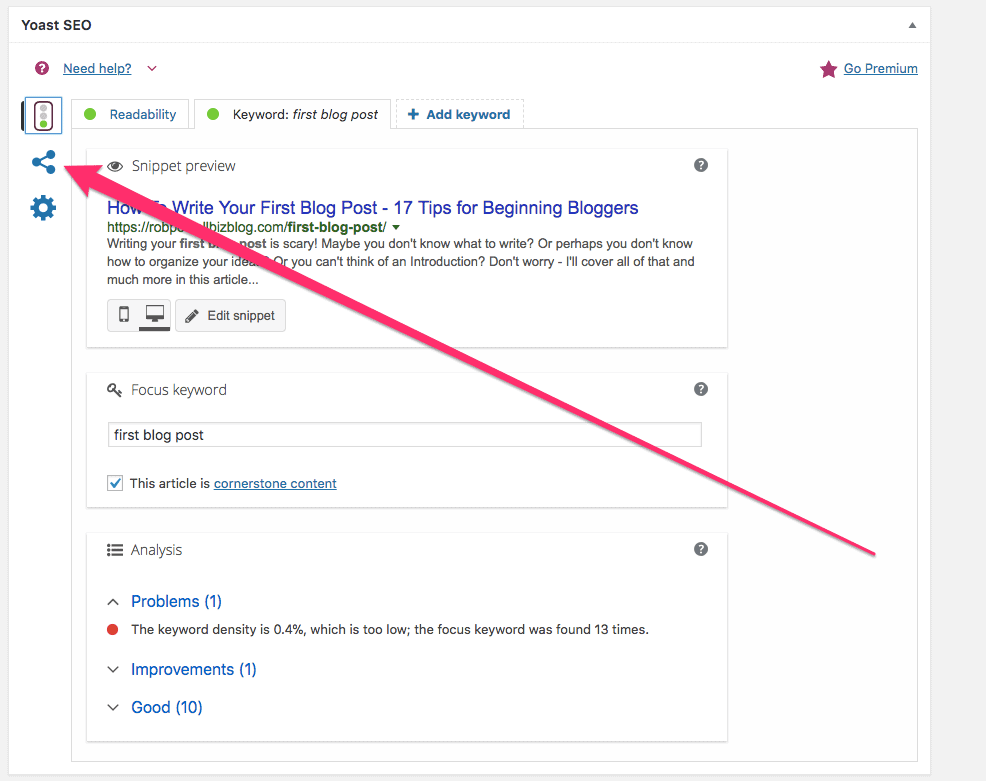
On the next screen you’ll see tabs for Facebook and Twitter:
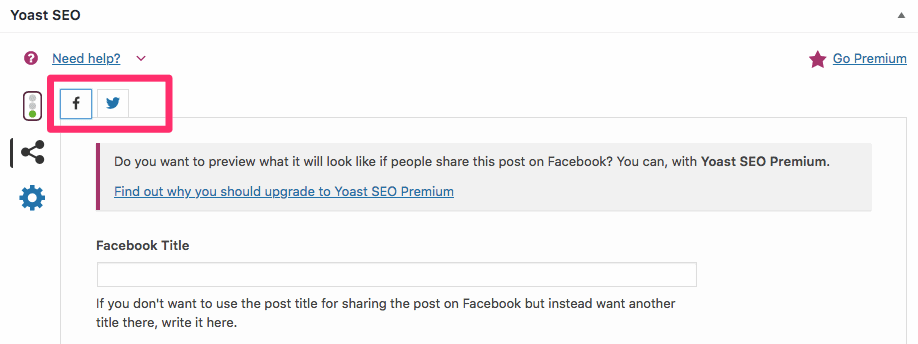
For each platform, Yoast will ask you to optimize the Title, the Description, and the Image.
Beneath the image field, the application tells you the optimum image size for your Facebook post:
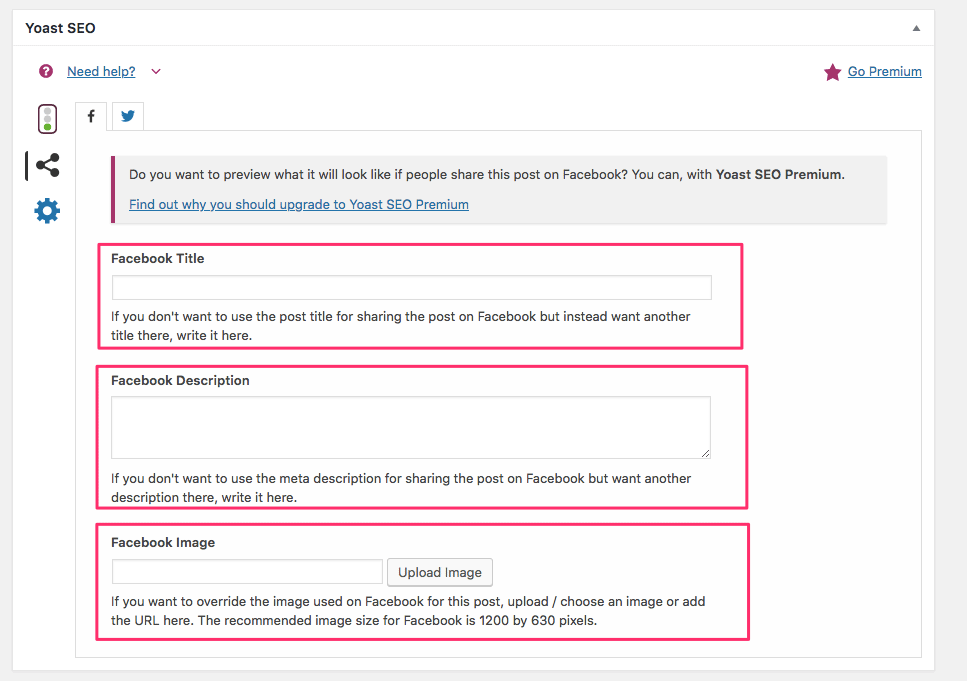
Add a captivating header image that will appear with your article title when people share on social media.
There are quite a few sites that offer free stock photos that you can use in your blog posts.
Here are some of them:
#5. Get Influencers Involved
If you implement only one of the share triggers in this article, this is the one.
Influencers have a compounding effect on the number of shares your article gets. When Noah Kagan and BuzzSumo analyzed over 100 million articles, they found that even having your article shared by just one Influencer increases your shares by 31.8%.
So, how do you get Influencers involved?
Well, you can reach out to them. But before making your move spend a few days or even a few weeks commenting on their posts and sharing their content. That way you’ll be getting on their radar. You’ll also be invoking the reciprocity principle (see Point #8).
But even more effective is getting Influencers involved in the creation of your blog post. What do I mean by that? Influencer roundup posts are a perfect example.
But there are two other ways to get Influencers involved:
- Interview an Influencer in your niche. Do the interview by email or by Skype. Once your interview post is live, let the Influencer know. More than likely they will share your article on social media.
- Write a ‘Top 20, 30, 40, or 50 List’. These kinds of posts are insanely popular among Influencers (just have a look at the number of shares on my Top 50 Marketing Experts on Twitter post).
#6. Use Images
Of all the known share triggers, this is perhaps the most important.
When BuzzSumo analyzed the data recently, they came up a startling fact: articles with an image once every 75-100 words get double the number of shares of articles with fewer images:

So when you’ve written your article, take the total word count, divide it by 100 and make sure your article contains about that number of images.
Here are some sites that offer free stock images:
#7. Write Long Form Content
A number of different experts have studied this factor and the results are conclusive: longer articles get shared much more than shorter articles.
Web entrepreneur Noah Kagan examined data representing over 100 million articles. His findings?
The longer your article, the more shares you’ll get, particularly on Facebook and Twitter:
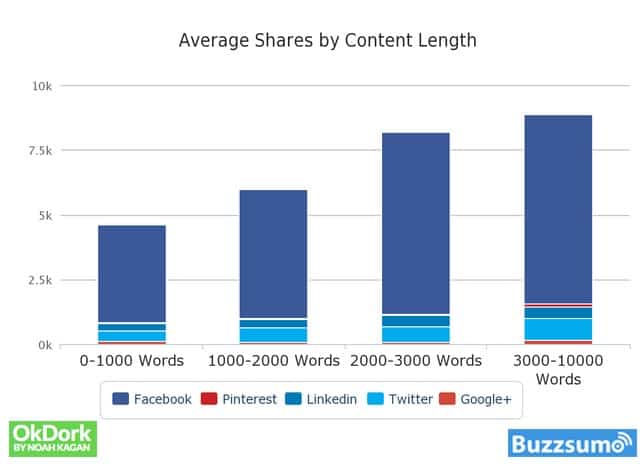
HubSpot carried out its own study of 6,912 articles. Their conclusion? Articles with more than 2,500 words got far more shares than shorter articles
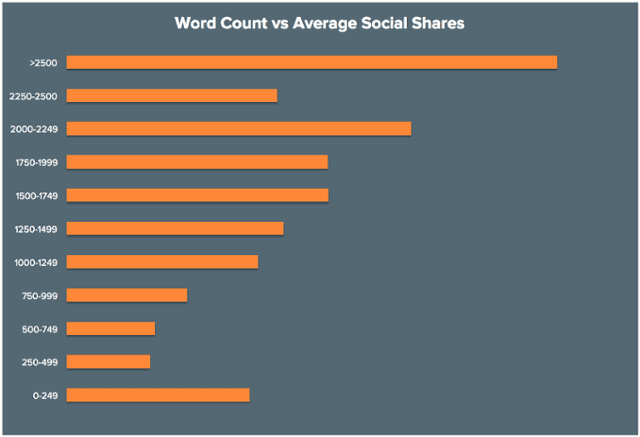
And here’s an interesting fact: according to OrbitMedia less than 5 percent of bloggers write posts longer than 1,500 words:
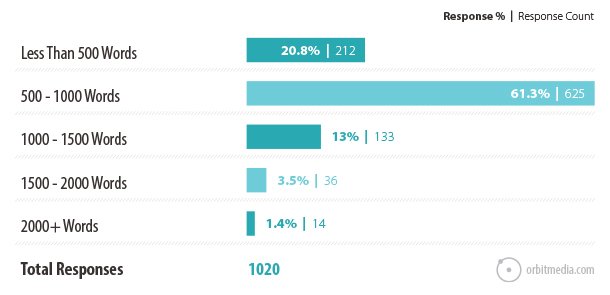
In other words, not only will you get more shares from writing articles of more than 1500 words, you’ll also have a huge advantage over other bloggers (because you’ll be in a small club of bloggers who comprise less than 5% of all bloggers).
#8. Trade Your Content For a Share
One of the share triggers used by a lot of websites is a simple trade: share this page and I’ll unlock some valuable content.
It would be nice to think that your visitors are so impressed with your content that they spontaneously share it.
But sometimes, people need to be prompted.
And that’s where a content locker comes in.
A content locker is simply a device you place on your web page that locks the content below until a desired action has been completed. That could be submitting an email address or, in our case, sharing your page on Twitter or Facebook.

But won’t this annoy my visitors?
It depends how you use it.
If you place the content locker in the middle of your article, it could indeed antagonize your readers. They may well feel that you promised something you haven’t delivered.
A much better way to use a content locker is to offer two or three bonus tips at the end of your article and put them behind a content locker. If your reader wants the bonus tips, they have to share your article.
Here are some Content Locker plugins:
#9. Use the Reciprocity Principle
In his book ‘The Psychology of Persuasion’, Dr. Robert Cialdini cites research that shows the power of reciprocity.
When a waiter gave a diner a mint, his tips increased by 3%, and when he gave a diner two mints, his tips increased by 23%.
But when the waiter left one mint with the bill and then returned with another mint, the tips increased by a staggering 23%!
What does this show?
That when you do something for someone else, they feel obliged to do something for you. To put it another way, when you do something for someone else, you set up an imbalance in the relationship. That imbalance can only be corrected when they do something for you.
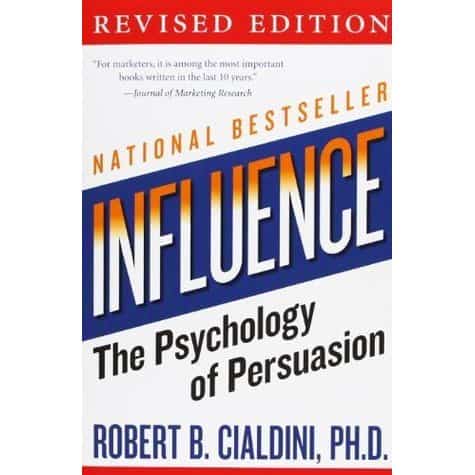
You can use this principle to get more shares for your content.
When you’ve written a really solid article, visit the websites of Influencers who write on that topic. Pick one of their articles that you like and share it on Twitter or Facebook.
Then contact them, let them know about your new article and say you’d love to get their feedback. In the next sentence mention their article, say how much you enjoyed reading it, and tell them that you shared it on Twitter or Facebook.
It won’t work every time, but very often they’ll share your article to their followers simply because you did something for them.
#10. Mention Other Bloggers
This is one of my favorite share triggers, and I’ve used it a lot!
When you’re researching your article, take note of well-known bloggers who write on that topic. Mention them, with a link to their article.
Then, once your blog post is live, drop them an email or send them a tweet (with a link to your article) to let them know you mentioned them.
Everyone likes being mentioned, and it’s more than likely they’ll share your article with their followers. And if they’re key influencers within your niche, they likely have large followings!
#11. Be Original
Content that goes viral is usually highly original. There are various ways of making your content more original. Here are some examples:
- Be controversial: take a contradictory position (e.g. ‘Why I don’t do keyword research’, or ‘Why I don’t write article outlines’)
- Do original research
- Insert more of your personality or your backstory into your writing
Conclusion
Share triggers are what make the difference between blog posts that fizzle out quickly and blog posts that travel the web for months on end, generating shares, traffic, and backlinks.
Use these 11 share triggers in your next blog post and watch as your articles take on a life of their own.
Thanks Amol, glad you got good results from it. All the best, Rob.